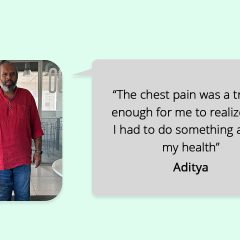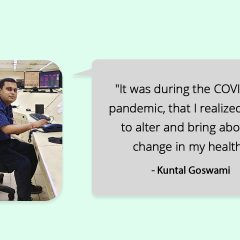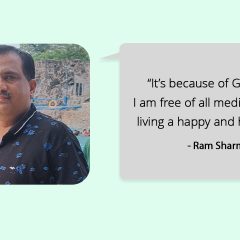 An Act of Courage
An Act of Courage
Rishabh’s body trembled almost imperceptibly, lips quivered and tears brimmed over. He was telling his friend about the time, two years ago, when he found out that he had failed his semester exams. The friend who was listening to him, looked somber and sighed, seeing how devastating the incident had been for Rishabh. “That must have been really hard for you. I am trying to imagine what it must have been like for you to handle the burden of it, all by yourself. I wish I had spoken to you and told you that failing a semester didn’t change the way I see you and how much you mean to me as a friend,” he said, his eyes mirroring his friend’s pain.
This is an example of an interaction between one person choosing to be vulnerable with another, who in turn, chose to respond with understanding, care and compassion. It doesn’t need a doctorate degree for one to recognize that it must have taken a lot of courage for the speaker to open up about something that brought on feelings of shame, sadness and isolation. At the same time his friend’s response was honoring of Rishabh’s experience of pain. And such a conversation could mark the beginning of a healing process.
What Does it Mean to be Vulnerable?
In her book, ‘Daring Greatly’, Dr. Brené Brown describes vulnerability as “uncertainty, risk, and emotional exposure.” It is that feeling of going out of your comfort zone, opening yourself up to the risk of being judged, and letting go of control to some extent. One of the biggest myths about vulnerability is that it is a sign of weakness. Our society propagates the idea that being strong means not being scared, hurt, confused or jealous. We are told that being strong is about not feeling fear and being in total control. This idea has been drilled into our minds and hearts for very long. But is that true? Does being strong mean being perfect? Does it mean pretending to be okay at all times? Or managing all our life problems independently and not taking support?
The answer is a big NO! It is a myth that most of us have been reeled into. Not feeling fear would require us to numb every other feeling along with it; every feeling that makes us human.
But Dr Brown says “When we think of times that we have felt vulnerable or emotionally exposed, we are actually recalling times of great courage”. She adds that, “Vulnerability is the birthplace of love, belonging, joy, courage, empathy, and creativity.” We make the assumption that the things that make us feel distressed and ashamed, are things that should be hidden and kept a secret. But not talking about them reinforces the voice in our heads that tells us that we are not good enough. That clearly is of no help and could aggravate the feelings of alienation & disconnection.
Like in the example at the beginning of this blog, when Rishabh chose to be vulnerable, it opened up an opportunity for a significant person in his life to witness important parts of him, thus validating his feelings and making him feel whole again. And it is that wholeness that allows us to understand and accept that making mistakes, going through challenges, or struggling in relationships, is not shameful, rather, it is what makes us human. Acceptance of our fragility, accelerates the healing process. 
Trying Out Vulnerability
If practicing vulnerability feels like too much of a leap for you, here are a few things that can help you begin:
- Start with something really small, like telling a friend or colleague about devouring 4 mangoes in one go or not having a shower all day or feeling anxious about an upcoming meeting.
- Whenever someone shares something with you, that makes them vulnerable, acknowledge their courage in sharing it with you and provide support with your listening and presence, without offering solutions or advice.
The Way Ahead
Let’s start one small step at a time in our own lives, because when you open yourself up to others and allow them to support and help you, you are also inspiring others around you to open up and thus helping the world to heal. As the famous author Haruki Murakami says “What happens when people open their hearts? They get better!”
We hope this article helps you. For more topics on mental health and emotional well-being, check out Healthy Reads or tune in to experts on GOQii Play.
Go get tips on improving mental and emotional health, connect with your GOQii Coach by subscribing for Personalised Health Coaching here.
#BeTheForce
 Many of us are worried about the impact of the ongoing pandemic on our elderly and physically vulnerable relatives. To top it off, the economic impact it has had around the world, right down to individuals being unable to work and ineligible for sick pay is huge. All this coupled with shortages in shops, cancellation of planned holidays and events have all caused some level of anxiety and distress. As these mental and emotional issues pile up, there’s a good chance that one might go over the edge. To avoid that, something must be done. During these trying times, there is something you can do to improve your mental and emotional wellbeing. That something is meditation!
Many of us are worried about the impact of the ongoing pandemic on our elderly and physically vulnerable relatives. To top it off, the economic impact it has had around the world, right down to individuals being unable to work and ineligible for sick pay is huge. All this coupled with shortages in shops, cancellation of planned holidays and events have all caused some level of anxiety and distress. As these mental and emotional issues pile up, there’s a good chance that one might go over the edge. To avoid that, something must be done. During these trying times, there is something you can do to improve your mental and emotional wellbeing. That something is meditation!  “Psychache” – It is a term coined by experts studying suicide. It refers to the unbearable psychological pain experienced by people, who consider suicide. Contrary to popular belief, suicide is less about attention seeking, manipulation or selfishness and more about an attempt to save oneself from excruciating pain (mostly psychological). People in the throes of suicide ideation, engage in such thinking especially when they are flooded by feelings of guilt, shame, worthlessness, inadequacy, social exclusion, anxiety, humiliation and ending their own life seems like the only way to save themselves from what appears to be inescapable suffering.
“Psychache” – It is a term coined by experts studying suicide. It refers to the unbearable psychological pain experienced by people, who consider suicide. Contrary to popular belief, suicide is less about attention seeking, manipulation or selfishness and more about an attempt to save oneself from excruciating pain (mostly psychological). People in the throes of suicide ideation, engage in such thinking especially when they are flooded by feelings of guilt, shame, worthlessness, inadequacy, social exclusion, anxiety, humiliation and ending their own life seems like the only way to save themselves from what appears to be inescapable suffering.
 In the first part of the article, we discussed
In the first part of the article, we discussed 


